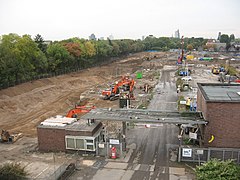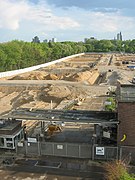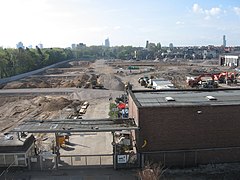Clouth Rubber Works
Clouth Gummiwerke AG was founded in 1868 by the Cologne entrepreneur Franz Clouth in the rubber goods industry, which wrote German industrial history with its products. Parts of the company were temporarily owned by Felten & Guilleaume and Continental AG . In 1990, Continental took over almost all of the shares. Some parts of the company were later sold and the rest of the production at the Cologne location was shut down in December 2009. The Clouth Quartier is currently being built on the former factory site .
Foundation phase
On September 10, 1862, Franz Clouth founded the company with the name Rheinische Gummiwarenfabrik . In 1864 the company was listed in the Cologne address book with the name Franz Clouth, commission business in rubber goods for technical purposes ; The company's headquarters were still located at 3 Sternengasse in Cologne , where the Clouth family's apartment was also located. The size of the business grew, so the business had to move. It took place in 1868 in the Cologne-Nippes district on an area of initially 10,000 square meters. Carl Vorberg, who was appointed authorized signatory, rose as co-owner in 1872 (until 1899) when Franz Clouth - Rheinische Gummiwaarenfabrik oHG ( sic ) was renamed. It is reported that Clouth rode daily from the family seat at Sternengasse 3 to Niehler Weg (today Niehler Straße 102). The first rubber products were household items such as milk bottle teats and suspenders , followed by industrial requirements such as roller covers, conveyor belts and drive belts. In 1870 there were already 70 employees; a 50 m high chimney (1872) and a steam engine (1892) heralded the start of industrial production. On September 14, 1891, the management of the company was transferred to the electrical engineer Georg Zapf. During this phase the company diversified strongly, diving equipment was manufactured (1882), which made the company the sole supplier of the Imperial Navy in 1887 . In 1890 the department Cable Works was founded here arose gutta percha - and fiber - telegraph cables and telephone cables for the kingdom Telegraph Administration (1893), the first node braided cables are used as city cable in Cologne (1895).
Land and sea cable works
Due to production reasons, the cable department expanded to an area of 20,000 square meters with 600 employees and was spun off on May 11, 1898 into Land- und Seekabelwerke AG , which was founded especially for this purpose . With the laying of the first submarine cable from Emden to New York, they won a spectacular contract. This project, carried out as part of the German-Atlantic Telegraph Company , went into operation on September 1, 1900. Another order brought the laying of cables in St. Petersburg in 1898 , which were only replaced in 2001. The laying of an underwater cable between Wangerooge and the Roter Sand lighthouse and the cabling of the Kiel Canal also caused a stir . The capital requirements of the submarine cable works were so great that leading Cologne and Berlin banks ( Bankhaus A. Levy & Co. , Cologne; Dresdner Bank AG , Disconto-Gesellschaft , private banks Bankhaus S. Bleichröder and Born & Busse) as a bank consortium had a stake of 50 percent took over, which they transferred in 1901 to the Cologne-based cable manufacturer Felten & Guilleaume . F&G took over the remaining 50 percent from the Clouth family in 1904, so that the land and sea cable works no longer belonged to the Clouth family.
wide range of products
In 1901 the remaining company was converted into a GmbH ( Rheinische Gummiwarenfabrik Franz Clouth GmbH ), which now belonged to Franz and his son Max Clouth. Count Ferdinand von Zeppelin visited the company in 1898 and brought with him an order for 18 large drum-shaped balloons that were to be hung in the frame of the first Zeppelin LZ1. In July 1900 the company also supplied the fabric cover for the LZ1. Clouth also developed and produced rubberized silk for the outer shell of LZ1. Balloon silk was also manufactured in the company, and finally the Clouth-Werke produced their own free balloons: "Clouth I" to "Clouth V". The "Clouth I" balloon was put into operation in May 1908. The airship was 42 meters long, 8.25 meters in diameter and had a gas volume of 1700 cubic meters, so it was relatively small. Franz Clouth's son Richard played a key role in its development. On July 14, 1907, the construction of an airship hangar began on the company premises, which was 45 meters long, 29 meters wide and 17 meters high. The first company-owned airship "Clouth I" was built here and was put into operation on May 1, 1908. However, the rubber industry's affinity for airships was nothing special at the time. Clouth also manufactured tires, initially for bicycles and later for automobiles. As a manufacturer of bicycle tires, the company initiated the establishment of the Cölner Bicycle Club , which had the Riehler Radrennbahn built in 1889 , which also spurred the bicycle boom in Cologne.
The plant developed into a specialist in rubber composite materials, a combination of rubber and other materials. In addition to diving suits, rubberized fabrics for wagon and horse blankets, children's toys, suits for miners and sailors, aprons and rubber gloves, tents, inflatables, medical rubber items and special products for defense technology were produced here. The wide range of products made the company with 680 employees (1910) the largest employer in the district. On June 3, 1910, the “Clouth” landed on the square in front of the “Bickendorf Military Airship Hall”. After the death of Franz Clouth in September 1910, his son Max took over the management of the GmbH, which still belonged to the widow and children of the deceased.
The core areas increasingly became industrial molded articles (e.g. for the automotive industry) and conveyor technology. On April 22, 1920, the company was converted into an AG ( Rheinische Gummiwarenfabrik AG Franz Clouth ) with a share capital of 6.5 million marks. This was completely taken over by the competitor F&G Carlswerk AG in 1925. In that year, the factory was expanded extensively (Halls 17, 18b) with the pavilion (Gate 2). From 1939 the factory was almost exclusively occupied with war production. Therefore, for the first time on 13./14. March 1942 targeted air raids against Clouth took place, which already caused a destruction of about 70 percent. On October 15, 1944, 90 percent of the factory premises were destroyed in another air raid, and on March 6, 1945, the factory was occupied by US soldiers. Production started again in October 1945, as conveyor belts from Cologne were urgently needed in the Aachen district and in the Rhenish lignite mining.
post war period
When Max Clouth died in September 1951, the Clouth family's interest in the company ended. The Clouth VIII rubber balloon started in December 1952 from the Bonn distribution group - Max Clouth never saw the start of his hobby. Steel cord belts were produced from 1955, and large-scale production could begin in 1957. Now there was rapid economic development, which was also reflected in the growth in the number of employees. While only 700 workers were employed in 1951, their number rose to 2,100 in 1961, only to reach a peak of 2,241 in 1962. In 1966 the tire manufacturer Continental AG had acquired 50 percent of the share capital of F&G, so that one of the buyers of the Clouth products became a partner.
The innovative product range of the Clouth company enabled inventions that led to a total of 30 patents. A vibration damper is the elastic rail bearing known as the " Cologne Egg ". The "Cologne Egg" was developed by Hermann Ortwein, an employee of Clouth Gummiwerke in Cologne-Nippes, and a patent was applied for on June 30, 1978. It was given the serial number 1403C. The "Cologne Egg" was first installed in 1978 on the Ebertplatz - Lohsestrasse route. Due to the excellent results (structure-borne noise reduction), the "Cologne Egg" was installed a short time later over a length of 1500 meters in the track of the KVB (Cologne Transport Company). Many other sections of the route followed. The installation was carried out wherever ballast bedding was undesirable for tracks, for example at bus stops. The soundproofing invention was installed 30,000 times in Cologne alone and is in use worldwide.
The "ISAD" patent was intended as a replacement for the starter, flywheel and alternator in cars and led to the foundation of the Clouth AG subsidiary ISAD-Systems GmbH in 1997.
From 1982 onwards it was known as Clouth Gummiwerke AG with the new shareholders (50 percent) Philips Communication Industry PKI and Continental AG (50 percent). In 1982 the factory area had grown to 146,000 square meters. In 1988 a high-performance production line for steel cord belts was built , the 90 m long plant of which could produce steel cord belts with an annual capacity of up to 80,000 meters. From 1987 the Clouth AG got into a company crisis, triggered by product liability for defective products. This resulted in significant losses and in 1989 the crisis bottomed out. In 1990, Continental increased its stake to 98.29 percent of the share capital after approval by the Federal Cartel Office in March 1990 .
End of the company
One of the main lines of production, rubberized fabric, was discontinued on March 31, 1992. In that year the crisis was over. Finally, for further restructuring, it was decided to merge Clouth Gummiwerke AG with Continental AG retrospectively from January 1, 1997, when Clouth AG , which was burdened with considerable loss carry-forwards , belonged to ContiTech . The conveyor belt systems were brought into the Transportbandsysteme GmbH (Clouth plant) . One area was not merged, but came to the C. Hilzinger-Thum Group (Tuttlingen) via Clouth Gummiwalzen GmbH & Co. KG (Bergheim ). Most of the Clouth products are still at ContiTech. Norbert Ackmann GmbH (Hessisch Oldendorf) still produces the Clouth rubber roll spring and other industrial parts for mechanical engineering today. With elastoBAY eK, ContiTech has hired a former Clouth employee to look after the market. On June 17, 2003, the city of Cologne decided to acquire the 160,000 square meter company site in order to use it for residential construction and “non-disruptive business”. It had to be taken into account that the development on Niehler Strasse is a listed building. Conveyor belts were manufactured here until December 16, 2005, and Clouth Gummiwerke AG has been part of Germany's industrial history ever since.
- Demolition work at the beginning of 2012 and new construction beginning in mid-2013 as seen from gate 4
The demolition of the factory halls lasted until 2013. On the area of approx. 14.5 hectares that will be vacated, the Clouth Quartier will be one of the largest new housing developments in Cologne by 2021 . Around 1100 apartments will be built. In addition, commercial spaces with a total area of around 25,000 square meters as well as areas for creative professions will be created.
Web links
- Rhenish industrial culture via Clouth
- Early documents and newspaper articles on Clouth Gummiwerke in the 20th century press kit of the ZBW - Leibniz Information Center for Economics .
Individual evidence
- ↑ Peter Fuchs (Ed.), Chronicle of the History of the City of Cologne , Volume 2, 1991, p. 148
- ^ University of Cologne: Wolffs, The establishment of the Dresdner Bank , undated, p. 135 (PDF; 2.9 MB)
- ^ Rüdiger Haude, Grenzflug , 2007, p. 87
- ↑ Udo Schmidt-Arndt: The Cologne Radrennbahnen 1889-1996 . Cologne 1996, p. 4.f.
- ^ Clouth annual report 1942
- ↑ Clouth entries on Patent.de
- ↑ which in 1979 completely acquired Felten & Guilleaume
- ↑ Handelsblatt No. 103 of June 1, 1989, p. 124
- ↑ Handelsblatt No. 4 of January 15, 1990, p. 15; the Cartel Office had already prohibited this intention in 1978 and 1981
Coordinates: 50 ° 57 ′ 55.5 " N , 6 ° 57 ′ 41.4" E









